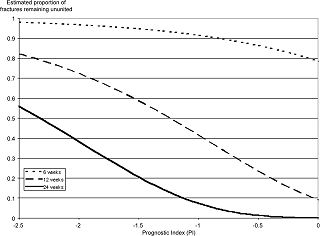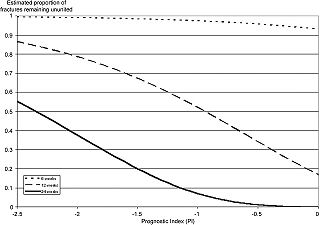Risk of non-union estimation
The management of clavicle fractures is often confusing, however a recent article in the JBJS, with a review of 858 clavicle fractures managed non-operatively, has provided a useful calculation of the prognosis and risk of non-union.
see: Robinson et al. J Bone Joint Surg Am. 2004 Jul;86-A(7):1359-65.
Mid-shaft clavicle fractures
Prognostic index = [-0.85 x (1 if displaced or 0 if undisplaced)] + [-0.36 x (1 if female or 0 if male)] + [-0.37 x (1 if comminuted fracture or 0 if noncomminuted fracture)] + [-0.01 x (age of patient in years)].
Pop-up Calculator
Lateral third fractures
Prognostic index = [-0.97 x (1 if displaced or 0 if undisplaced)] + [-0.02 x (age of patient in years)].
Pop-up Calculator
Examples
A patient with a prognostic index of –2 (for example, a sixty-year-old woman with a displaced, comminuted diaphyseal fracture) has a 72.4% projected probability that the fracture will remain ununited at twelve weeks and a 38.3% probability of nonunion at twenty-four weeks, whereas a patient with a prognostic index of –1 (for example, a twenty-two-year-old man with a displaced but noncomminuted fracture) has a 41.6% probability that the fracture will remain ununited at twelve weeks and only a 7.4% probability of nonunion at twenty-four weeks. This suggests that earlier surgery might be beneficial for patients with a lower prognostic index.
See the original article here




